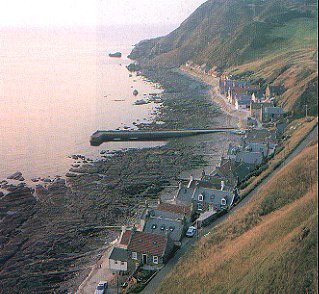
Scotland's north-east corner offers a tremendous
variety of scenery to tempt walkers, from the magnificent high tops of the Cairngorms to
wild and rugged glens, long river valleys and a superb and generally under-explored
coastline.
Cairngorms and the
West
The western boundary of the area is formed by two great salmon rivers, the Findhorn and
the Spey, rising in the high moorland of the Monadliath Mountains to run down to the North
Sea at the Moray Firth. On their way each, especially the Spey, passes through an
attractive mix of hill, forest and valley scenery, and the Speyside Way long-distance path
follows its river from the mouth of Tugnet as far up as Ballindalloch before turning
inland to Tomintoul.
On its way it crosses Glenlivet, where the Crown
Estate has laid out a whole series of walks. All the walks are waymarked and many are
suitable for children. Tomintoul, the highest village in Highland Scotland, is at the
eastern edge of the Cairngorms, and from here Glen Avon rises amid superlative scenery to
Loch Avon under the imposing cliffs of Ben Macdui.
Royal Deeside
Another great salmon river, the Dee, also rises in the Cairngorms, passing through Braemar
and running down Royal Deeside to Aberdeen. Around it is great walking country, with
summits such as Lochnagar tempting the hillwalker and much of interest on the lower
ground, which is well-wooded. Parts of the former railway line from Ballater to Aberdeen
have been turned into a walkway.
The North East
Further north and east, the hills are lower but still offer grand walking.
Bennachie is very much a local favourite, and has an excellent visitor centre at its foot.
A whole series of walks has been developed around the attractive market town of Huntly.
The Grampian region has a truly superb
coastline, with many beautiful villages, coves, castles and cliffs. There is good coastal
walking from Findhorn and Burghead along through Cullen, Findlater Castle, Portsoy and
Pennan. The coast turns at the major fishing port of Fraserburgh and runs south through
Peterhead and past the cliffs known as the Bullers of Buchan, renowned for birdlife and
Slains Castle, said to have inspired Bram Stoker to write Dracula, to Cruden Bay.
Much of the east coast is sandy, and from the
bird reserve at the Sands of Forvie on the estuary of the River Ythan, through Newburgh
and down to Aberdeen, is a glorious sweep of beach and fine coastal walking to go with it.
It might seem a long way from here to the summit of Ben Macdui in the Cairngorms,
Britain's second highest mountain, but it is all part of the same, beautiful area.
Tomintoul
The Highest Town in the Highlands and the Healthiest (pdf) |
